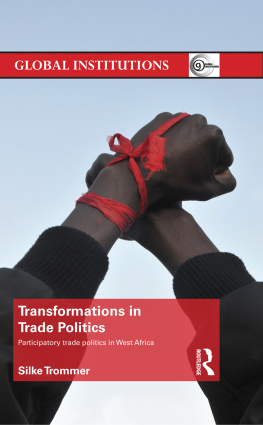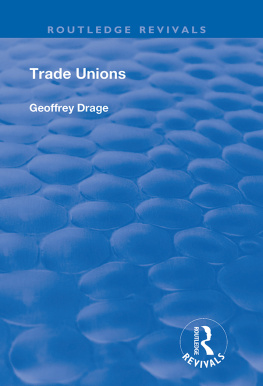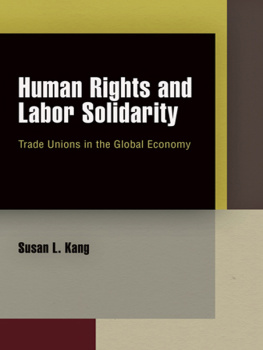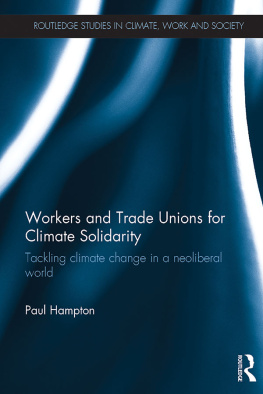WOMEN AND TRADE UNIONS
In memory of Alice Cook
Women and Trade Unions
A comparative perspective
Jennifer Curtin
First published 1999 by Ashgate Publishing
Reissued 2018 by Routledge
2 Park Square, Milton Park, Abingdon, Oxon, OX14 4RN
52 Vanderbilt Avenue, New York, NY 10017
Routledge is an imprint of the Taylor & Francis Group, an informa business
Copyright Jennifer Curtin 1999
All rights reserved. No part of this book may be reprinted or reproduced or utilised in any form or by any electronic, mechanical, or other means, now known or hereafter invented, including photocopying and recording, or in any information storage or retrieval system, without permission in writing from the publishers.
Notice:
Product or corporate names may be trademarks or registered trademarks, and are used only for identification and explanation without intent to infringe.
Publisher's Note
The publisher has gone to great lengths to ensure the quality of this reprint but points out that some imperfections in the original copies may be apparent.
Disclaimer
The publisher has made every effort to trace copyright holders and welcomes correspondence from those they have been unable to contact.
A Library of Congress record exists under LC control number: 99072328
ISBN 13: 978-1-138-37052-4 (hbk)
ISBN 13: 978-0-429-42797-8 (ebk)
Many people provided me with assistance in the process of this research. First, my thanks go to Frank Castles and Barbara Sullivan for their intellectual guidance and support. Second, this work would not have eventuated without the contributions of the women unionists whom I interviewed and to them I am extremely grateful. Thanks go to Jelle Visser and Bernhard Ebbinghaus for providing me with data from the DUES data set, to Bo Rothstein, Michael Shalev, Gillian Whitehouse, Winton Higgins, David Peetz, Diane Sainsbury and Moshe Semyonov for feedback on early drafts, and to Gudrun Biffl, Bernhard Kittel, Wolfgang Pollan, Franz Traxler and Gary Chaison for their help with sources and clarification. Others who have given me encouragement, assistance and friendship include Shirin Ahlback, Christina Bergqvist, Heather Brook, Jenny Chalmers, Lorraine Elliott, Paul Grimes, Rolf Gerritsen, Andre Moore, Rebecca Stringer, Fiona Webster and my family. I would also like to mention Tony and Molly Beirne, Jenny Farley, Joyce Gould, Lois Gray, Beth Leslie, Gormley Miller, Robin Ingram, Ingrid Reischl, Zachary and Arza Sheaffer, Per Strand, Rose Ward and Birgit Weiss whose generosity and support were invaluable while I was researching abroad. Very special thanks is reserved for Craig Symes and Heather Devere. Finally, acknowledgement must go to Anne Keirby and Rachel Hedges of Ashgate for their patience, to Ruth Bader for assistance with formatting, and to the Swedish Institute for the Council of Europe Scholarship which greatly enhanced my research pursuits in Sweden. The book is dedicated to Alice Cook whose work first inspired me to pursue this topic. Alice took the time to discuss with me my initial thoughts and provided me with encouragement and access to sources and contacts, all of which have proved invaluable.
December 1998
- ACTU Australian Council of Trade Unions
- AS Austrian Schillings
- DUES The Development of Trade Unions in Western European Societies Project, Mannheim Centre for European Social Research, University of Mannheim.
- EEO Equal Employment Opportunity
- ETUC European Trade Union Confederation
- HREOC Human Rights and Equal Opportunity Commission
- ICFTU International Confederation of Free Trade Unions
- ILO International Labour Organisation
- KOM Women and Men Working Together
- LO Swedish Confederation of Trade Unions
- NSW New South Wales
- OECD Organisation for Economic Co-operation and Development
- OGB Austrian Confederation of Trade Unions
- SACO Swedish Confederation of Academics.
- SAF Swedish Employers' Association
- SSGCW State Secretariat for the General Concerns of Women
- TCFUA Textile, Clothing and Footwear Union of Australia
- TCO Central Organisation of Salaried Employees.
- TDC Trade Development Council
- UK United Kingdom
- US United States
- WTUC Women's Trade Union Commission
- WTUL Women's Trade Union League
Since the emergence of the labour movement in response to industrialisation, trade unions have had a mixed record on the representation of women workers. In the past, women have been excluded from membership, denied access to decision-making positions, and some trade unions have acted to reinforce rather than challenge women's inequality in the paid workforce.
Yet, from the 1960s onwards, women have become a permanent fixture in the paid labour force and, in many countries, women make up a substantial component of trade union membership. It is in this context that Cobble notes "the potential for forging a creative productive partnership between working women and unions is greater now than at any other time" (Cobble, 1993, p. 4). The aim of this book is to examine the extent to which such a "partnership" has been developed between women workers and trade unions. More specifically, I analyse how women trade unionists have sought to make trade union structures and policy agendas more inclusive of the interests of women workers in four countries: Australia, Austria, Israel and Sweden.
There has been a considerable increase in research concerning women over the last twenty years or so, and with it, the historical and contemporary situation of women in trade unions has emerged as an object of serious scholarly inquiry. Historical analyses of women and their interaction with trade unions rectify the previous invisibility of women's position within the labour movement (Collette 1989; Frances 1991; Milkman, 1985; Shute, 1994; Soldon, 1985; Street, 1994). Contemporary developments in the relationship between women and trade unions have also received increasing attention in the literature (Acker, 1994; Bergqvist, 1991; 1995; Briskin, 1993; Gardner, 1983; Lawrence, 1994; Pocock, 1995a; Pocock, 1997). With a few exceptions (see Cook, Lorwin and Daniels, 1984; 1992; Gelb, 1989; O'Donnell and Hall, 1988), this literature has not been comparative in nature; a gap this book begins to fill.
The continuing absence of women within the elites of political institutions has become an increasingly salient topic of late, both within the theory and practice of politics. Much of the focus of new democratic theorising and practice has been primarily on the absence of women in parliaments (Phillips, 1991; 1995; Sawer and Simms, 1993) and the bureaucracy (Eisenstein, 1991; Sawer 1990; Yeatman, 1990). Trade unions also need to be included in this debate since they play a critical role in the representation of workers' interests to both employers and governments. This book contributes to an assessment of democratic practice within trade unions by examining how workers' interests are defined and redefined and how women are provided with a voice in this process.
I have selected Australia, Austria, Israel and Sweden for a number of reasons. First, they exhibit several similarities (cf Przeworski and Tuene, 1970). In all four countries, a trade union movement exists which has encompassed a majority of wage earners, and has union confederations which are strong and centralised. All have close links to parties on the left. In Sweden, Austria and Israel, parties of the left have enjoyed a large electoral following and have participated as leading or equal partners in government for over 30 years. While this has not been the case in Australia, the Australian Labor Party did have an uninterrupted thirteen year period of majority government between 1983 and 1996, during which time an institutionalised relationship developed between union and party elites.








